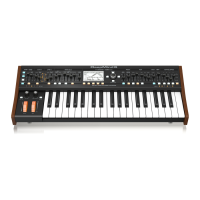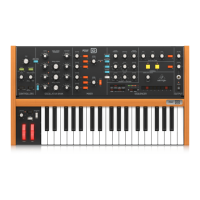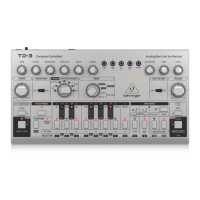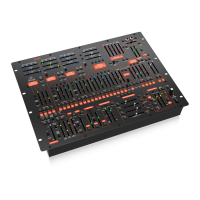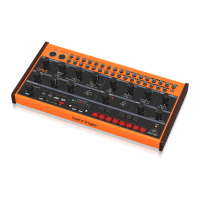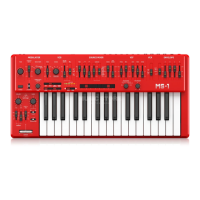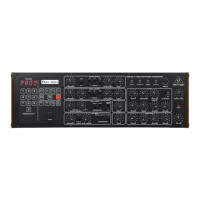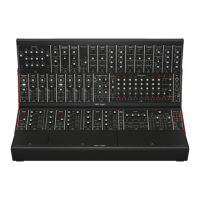97 DeepMind 12 User Manual
Delay + Chamber
Here we have combined Delay and Chamber reverb, so a single device can provide
a variety of delay settings, plus add just the right type and amount of reverb to
the selected signal. This device only uses one FX slot. (Inspired by the Lexicon
PCM 70.)
Use the BALANCE knob to adjust the ratio between delay and reverb.
Lowfrequencies can be excluded with the LO CUT knob, and the MIX adjusts
how much of the eect is added to the signal. The TIME knob adjusts the delay
time for the left channel delay, and the PATTERN sets the delay ratio for the
right channel delay. Adjust the FEEDBACK and trim some high frequencies with
the FEED HC (high-cut) knob. The XFEED knob allows you to send the delay
sound to the reverb eect, so instead of running completely parallel, the reverb
aects the echoes to a selected degree. The PREDELAY knob determines the
hesitation before the reverb aects the signal. The DECAY knob adjusts how
quickly the reverb fades. The SIZE controls how large or small the simulated
space is (room,cathedral, etc.). The DAMPING knob determines the decay of high
frequencies within the reverb tail.
Flanger + Chamber
Add the mind-bending, lter-sweeping eect of a state-of-the-art Flanger to the
elegant sweetening of a traditional Chamber reverb - all in one FX slot. (Inspired
by the Lexicon PCM 70.)
The BALANCE knob adjusts the ratio between anger and reverb. Low frequencies
can be excluded with the LO CUT knob, and the MIX knob adjusts how much
of the eect is added to the signal. SPEED, DELAY and DEPTH adjust the rate,
delay,and modulation depth of the anger. FEEDback can be adjusted with
positive and negative amounts. The PHASE can be o set by up to 180 degrees.
The PREDELAY knob determines the hesitation before the reverb aects the
signal. The DECAY knob adjusts how quickly the reverb fades. The SIZE controls
how large or small the simulated space is (room, cathedral, etc.). The DAMPING
knob determines the decay of high frequencies within the reverb tail.
MidasEQ
The Midas EQ is a four-band sweep parametric equalizer taken from the Midas
Pro X console that allows tonal control of the input signal via the parametric EQ
section. The mid bands also have a Q Factor adjustment to tailor the shape of the
EQ curve. The four bands are low, low mid, high mid and high. Any combination
of the four bands can be used to control the signal.
Enhancer
These Enhancers are so called “Psycho EQs”. They can enhance the signal
spectrum in bass, midrange and high frequencies but they dier from traditional
equalizers. When you need to generate maximum punch, clarity and detail,
without turning up the overall volume, our enhancers are the solution.
(Inspiredby the SPL Vitalizer.)
Adjust the BASS, MID and HI GAIN knobs to add or reduce content in those
spectrums. The BASS and HI Frequencies can be specically selected, while the
MID Q (bandwidth) can be adjusted instead. The OUT GAIN knob compensates for
changes in level resulting from the eect, and the SPREAD knob (Stereo version
only) emphasizes the stereo content for a wider mix. Engage the SOLO MODE
to isolate only the audio resulting from the eect so you can hear exactly what
you’re adding to the mix.
Fair Compressor
This model of a Fairchild 670 delivers some of the nest colorations in compressor
history. The two paths L/M and R/S both have the same functionality. The
controls include input GAIN, THRESHOLD, TIME and DC BIAS (which controls the
ratio and knee of the compression curve. There is also a BIAS BALANCE which can
help accentuate attacks. There are modes available for dual, stereo-linked, or
mid/side operation via the MOD control.
MulBndDist
The Multiband Distortion unit, useful for making sound gritty, adding more
warmth through saturation, or even enhancing a specic frequency region. There
are three bands, adjustable by a 24 dB per octave crossover lter.
There are six distortion types, going from soft saturation to more aggressive
distortion and post lter variants. The 'Drive' parameter controls the amount
of distortion introduced to the sound. This parameter, together with the right
distortion type, can instead bring some soft saturation to the sound.
The eect also features a Cabinet Unit applied to the output, which can add the
characteristic timbre of 11 dierent cabinet types.
Finally the level of the sound can be controlled by the input and output gain
parameters.

